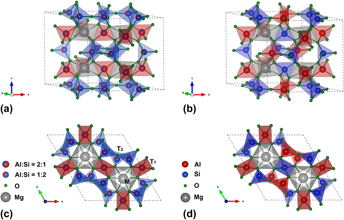Crossref Citations
This article has been cited by the following publications. This list is generated based on data provided by
Crossref.
Zhou, Yanchun
Xiang, Huimin
and
Smith, D.
2016.
Al5BO9: A Wide Band Gap, Damage‐Tolerant, and Thermal Insulating Lightweight Material for High‐Temperature Applications.
Journal of the American Ceramic Society,
Vol. 99,
Issue. 8,
p.
2742.
Li, Yiran
Tian, Zhilin
Luo, Yixiu
Wang, Jiemin
Sun, Luchao
Zheng, Liya
and
Wang, Jingyang
2017.
Pressure-induced low-lying phonon modes softening and enhanced thermal resistance inβ−Mg2Al4Si5O18.
Physical Review B,
Vol. 95,
Issue. 5,
Li, Yiran
Wang, Jiemin
Sun, Luchao
and
Wang, Jingyang
2018.
Mechanisms of ultralow and anisotropic thermal expansion in cordierite Mg2Al4Si5O18: Insight from phonon behaviors.
Journal of the American Ceramic Society,
Vol. 101,
Issue. 10,
p.
4708.
Liu, Yuchen
Liu, Bin
Xiang, Huimin
Zhou, Yanchun
Nian, Hongqiang
Chen, Hongfei
Yang, Guang
and
Gao, Yanfeng
2018.
Theoretical investigation of anisotropic mechanical and thermal properties of ABO3 (A=Sr, Ba; B=Ti, Zr, Hf) perovskites.
Journal of the American Ceramic Society,
Vol. 101,
Issue. 8,
p.
3527.
Liu, Bin
Liu, Yuchen
Zhu, Changhua
Xiang, Huimin
Chen, Hongfei
Sun, Luchao
Gao, Yanfeng
and
Zhou, Yanchun
2019.
Advances on strategies for searching for next generation thermal barrier coating materials.
Journal of Materials Science & Technology,
Vol. 35,
Issue. 5,
p.
833.
Shimamura, Akihiro
Fukushima, Manabu
Hotta, Mikinori
and
Kondo, Naoki
2020.
Effect of thermal conductivity of ceramic compact on the porous structures of foamed bodies via direct-foaming method.
Journal of Asian Ceramic Societies,
Vol. 8,
Issue. 1,
p.
176.
Hammas, Aghiles
Lecomte‐Nana, Gisèle
Daou, Imane
and
Zibouche, Fatima
2020.
Sintering and final properties of kaolinite‐magnesite tapes for the manufacture of cordierite‐mullite ceramics.
International Journal of Applied Ceramic Technology,
Vol. 17,
Issue. 5,
p.
2265.
Luan, Xuezhu
Li, Jinhong
Wang, Ziyao
Feng, Wuwei
Huang, Kaiyue
and
Liu, Shuo
2021.
Hierarchically cell-window structured porous cordierite prepared by particle-stabilized emulsions using potato starch as a modifier.
Journal of the European Ceramic Society,
Vol. 41,
Issue. 7,
p.
4369.
Liu, Bin
Zhao, Juanli
Liu, Yuchen
Xi, Jianqi
Li, Qian
Xiang, Huimin
and
Zhou, Yanchun
2021.
Application of high-throughput first-principles calculations in ceramic innovation.
Journal of Materials Science & Technology,
Vol. 88,
Issue. ,
p.
143.
Liu, Hanwen
Liu, Ling
Xiang, Huimin
Dai, Fu-Zhi
Wang, Xiaohui
Huang, Muzhang
Wan, Chunlei
Ma, Zhuang
Liu, Yanbo
Li, Hezhang
and
Zhou, Yanchun
2022.
Orthorhombic to tetragonal polymorphic transformation of YTa3O9 and its inhibition through the design of high-entropy (Y0.2La0.2Ce0.2Nd0.2Gd0.2)Ta3O9.
Journal of the European Ceramic Society,
Vol. 42,
Issue. 8,
p.
3559.
Li, Yiran
Wu, Qi
Lai, Mengling
Zhao, Juanli
Liu, Yuchen
Fan, Yun
Yao, Yun
and
Liu, Bin
2022.
Influence of chemical disorder on mechanical and thermal properties of multi-component rare earth zirconate pyrochlores (nRE1/n)2Zr2O7.
Journal of Applied Physics,
Vol. 132,
Issue. 7,
Luan, Xuezhu
Li, Jinhong
Feng, Wuwei
Liu, Rui
Liu, Shuo
and
Wang, Ziyao
2022.
Structure-Controlled Porous Cordierite Ceramics with High Solid Content Prepared by Pickering Emulsion Technique Using Sucrose as a Porogen.
Materials,
Vol. 15,
Issue. 9,
p.
3410.
Zhou, Meng Fei
Hu, Cheng Chao
Yin, Jian Bing
Jiang, Yu
Liu, Bing
and
Song, Kai Xin
2022.
Cold sintering optimized SrF2 microwave dielectric ceramics for the development of dielectric resonator antenna at 5G millimeter-wave band.
Ceramics International,
Vol. 48,
Issue. 20,
p.
29847.
Li, Buda
Li, Menglu
Qi, Hangbo
Zhao, Siqin
Feng, Shan
Zu, Xiaotao
Qiao, Liang
and
Xiao, Haiyan
2023.
The effects of tungsten doping on the mechanical properties of Bi2O2Se.
Journal of the American Ceramic Society,
Vol. 106,
Issue. 10,
p.
6026.
Li, Buda
Li, Menglu
Qi, Hangbo
Zu, Xiaotao
Qiao, Liang
and
Xiao, Haiyan
2023.
The Effects of Chlorine Doping on the Thermoelectric Properties of Bi2O2Se.
Crystals,
Vol. 13,
Issue. 11,
p.
1586.
Li, Buda
Qi, Hangbo
Li, Menglu
Zu, Xiaotao
Qiao, Liang
and
Xiao, Haiyan
2023.
The Effects of Chlorine Doping on the Mechanical Properties of Bi2O2Se.
Crystals,
Vol. 13,
Issue. 10,
p.
1492.
Raval, Dhara
Moujaes, Elie A.
Gupta, Sanjeev K.
and
Gajjar, P.N.
2024.
Novel penta-GeC5 nanosheet as potential candidate for efficient thermoelectric application: A DFT approach.
Journal of Physics and Chemistry of Solids,
Vol. 193,
Issue. ,
p.
112157.
Chen, Lin
Li, Baihui
and
Feng, Jing
2024.
Rare-earth tantalates for next-generation thermal barrier coatings.
Progress in Materials Science,
Vol. 144,
Issue. ,
p.
101265.



